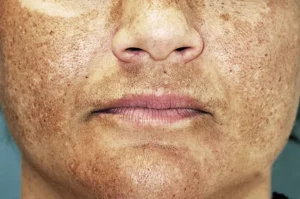 Melasma Treatment in Ayurveda is an effective and natural way of treating melasma. In Ayurveda melasma is compared with Vyangya. It is described as a painless blueish black patch occurring especially on the face. Various Ayurvedic research has shown that melasma treatments in Ayurveda have shown significant improvements in melasma patients.
Melasma Treatment in Ayurveda is an effective and natural way of treating melasma. In Ayurveda melasma is compared with Vyangya. It is described as a painless blueish black patch occurring especially on the face. Various Ayurvedic research has shown that melasma treatments in Ayurveda have shown significant improvements in melasma patients.
Have you ever been scared of patches on your face mainly brownish patches on your face? If yes, you should know more about melasma. There should be a reason for your skin to manifest such a change. What could be that?
Melasma is a cosmetic problem that affects predominantly women compared to men. A person who is having melasma has an impact on appearance as it mainly affects the face causing emotional and psychological distress along with a reduced quality of life.
What is melasma?
Melasma is a common skin problem that causes changes in normal skin pigmentation. It is usually seen on unexposed areas of the body.
Melasma is come common in females compared to men.
The word melanoma is derived from the Greek root “melas”, which means black. It was also called Chloasma derived from Greek means ‘greenish’ but now the term melanoma is widely used.
Melasma is also known as the ‘Mask of pregnancy’ as it was seen more during pregnancy.
Causes for melasma
Hormonal changes, UV ray exposure, excess sunlight exposure, family history, age-related changes, pregnancy-related changes, use of oral contraceptives, etc can be the reason behind those patches on your face. Sometimes melasma is also called pregnancy shield and another name is chloasma. Melasma is also seen in women who take oral contraceptives.
At What age, Melasma is seen?
Melasma is seen between 20 and 40 years depending on pregnancy and the use of oral contraceptives.
What does melanoma look like?
Melasma is seen commonly in women. Darker pigmentation affects the upper lip, malaria regions, forehead, and chin. The pigmentary changes are seen bilaterally and symmetrical
Classification of melasma
Three types of melasma are mainly
Epidermal type _with the light brown colour of patches,
Dermal type _with the bluish-grey colour of patches and
Mixed type -with the dark brown colour of patches.
Ayurvedic view of melasma – Vyanga Vyanga occurs due to various reasons like suppression of vomiting, day sleep, intake of incompatible food combinations Viruddha Ahara, excess intake of hot spicy food, etc as per Ayurvedic classics. Taking excessive strain for speaking, singing, etc can also add to cause this condition.
Classification of Vyanga
Vata type – patches are bluish-black in colour
Pitta type – patches with edges coppery red in colour
Kapha type- white, itchy patches
Rakta type – red patches with tingling and burning sensation
How does Vyanga manifest on the skin?
General pathophysiology associated with this – Pitta and Vata when vitiated affects the second layer of skin called Lohita causing painless blackish circular discoloration called Vyanga.
Diet and lifestyle tips for melasma
Avoid all food that causes an imbalance in the Rakta, pitta, and kapha energies in the body.
Add green gram, rice, wheat, and green veggies to your diet
Add yoga practises like Surya namaskar, Bhujangasana , Sarvangasana in your daily routine.
Practise Anuloma viloma pranayama for regulating breathing and increased blood flow to sense organs and face. This will also help to get a positive outlook and get a relaxed pleasant state of mind always. Give at least one hour to these lifestyle practices and you will be able to get better results.
Melasma Treatment in Ayurveda
Melasma Treatment in Ayurveda depends on the severity of the disease. In early-stage melasma is treated effectively using ayurvedic medicines, dietary, and lifestyle changes.
When melasma is chronic in nature one may need to undergo detoxification therapies (panchakarma treatment) to cleanse the body and bring the balance to doshas. Ayurvedic detoxification helps in correcting hormonal imbalances and increases the efficacy of the medicines.
Venesection (Sira vyadhana ),
Leech therapy (Jalouka avacharana ),
Herbal paste application (Mukha Lepa),
Oil application on the face,
Nasal installation of, medicinal drops (Nasya)
all these are told as therapeutic procedures helpful to manage your condition.

